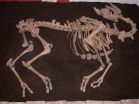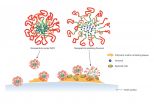The research is the first global analysis of the effects of forest cover change on local temperature using high-resolution NASA global satellite data. A peer-reviewed paper based on the study, "Local cooling and warming effects of forests based on satellite observations," hints at how land use policies could have economic implications from forest to farmland.
"Understanding the precise mechanisms of forest-generated warming or cooling could help regional management agencies anticipate changes in crop yields. Together with a knowledge of other ecological factors, this information can help decision makers and stakeholders design policies that help to sustain local agricultural practices," said Safa Motesharrei, co-author of the paper and a systems scientist at the National Socio-Environmental Synthesis Center (SESYNC).
Agriculture--specifically, converting forest cover to plantations for oil palm, soy, rubber, coffee, tea, rice, and many other crops--is widely believed to be one of the main causes of deforestation. Such change in land cover could drive a rise or fall in local temperature by as much as a few degrees. This kind of fluctuation could substantially impact yields of crops that are highly susceptible to specific climate conditions, resulting in harvests that are less productive and less profitable.
The authors say it underscores the need for a holistic understanding of forestry activities on local climate. They point out that while local impacts of forest cover change are some of the most relevant for management practices, they're also the most poorly understood.
The path to understanding these local impacts, the researchers say, is through albedo and evapotranspiration. Forests have a darker surface than, for example, an agricultural field--forests therefore have a lower albedo, which means less solar radiation is reflected and more is absorbed. This phenomenon causes warming. On the other hand, forests absorb more rainwater and transpire it as water vapor later. This phenomenon, called evapotranspiration, causes cooling.
"These two competing biophysical effects could determine whether--at a specific location or during a specific time of the day or season of the year--a forest could cause local cooling or warming. And, by extension, whether clearing a forest could lead to a rise or fall in local temperature," explained Yan Li of Peking University, lead author of the study and visiting climate scientist at the University of Maryland.
For example, the researchers found that tropical forests, which occur closest to the equator, have a strong cooling effect year-round. Boreal forests, which occur furthest from the equator, and temperate forests, which occur between tropical and boreal forests, show a seasonal variation. Boreal forests have strong warming in winter and moderate cooling in summer with net warming annually, and temperate forests show moderate cooling in summer and moderate warming in winter with net cooling annually. The scientists say this difference in cooling or warming can be largely explained by whether albedo or evapotranspiration is the dominant effect.
The study addresses questions that have been previously impossible to answer without these global satellite data. Earlier research has studied the effects of forest cover on temperature using field observations or global climate models. Because field work can be expensive, time-intensive, and logistically difficult, field measurements are generally available for only limited areas. These data are therefore difficult to scale up to develop a global picture. And because climate models require immense computational resources to run, they're often unable to provide focused local information with reliable precision.
"It's difficult to get measurements that are both accurate at a fine scale and have a large enough coverage that they can inform global climate models," said Nicholas Magliocca, a computational research fellow at SESYNC who was not involved in the study. "This analysis offers an important empirical benchmark against which global climate models can be validated to accurately represent the temperature-mediating effects of forests."
The satellite data used in the study--collected by NASA's Moderate Resolution Imaging Spectroradiometer, or MODIS--provide the best of both worlds: information that is rich in detail and global in coverage. As a result, the researchers could effectively zoom in and back out again to analyze the same phenomena everywhere around the world.
"We knew before that forests have an impact on temperature. But this study has provided a precise, quantitative estimation of the impact of forests depending on the geographical location, tracing it back to the changes in albedo and evapotranspiration," said Eugenia Kalnay, co-author of the paper and a Distinguished University Professor at the University of Maryland.
As rates of deforestation climb and shifts in local climate become more pronounced, the need to understand the relationship between forest cover change and temperature will become more urgent. We have already lost 130 million hectares--an area roughly equivalent to twice the size of France--of the world's forests just in the past decade, according to the Food and Agriculture Organization of the United Nations. The more forests we clear, the more we increase risks for food production due to changes in temperature.
INFORMATION:
In addition to Li, Motesharrei, and Kalnay, the paper's co-authors include Maosheng Zhao, research assistant professor at the University of Maryland; Qiaozhen Mu, research scientist at the University of Montana; and Shuangcheng Li, professor at Peking University.
This research was supported by the National Natural Science Foundation of China (Nos. 41130534 and 41371096).
The research paper, "Local cooling and warming effects of forests based on satellite observations," was published online March 31, 2015, in the journal Nature Communications.
The National Socio-Environmental Synthesis Center, funded through an award to the University of Maryland from the National Science Foundation, is a research center dedicated to accelerating scientific discovery at the interface of human and ecological systems. Visit us at http://www.sesync.org and follow us on Twitter @SESYNC.



